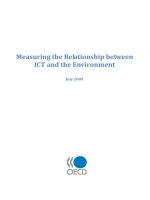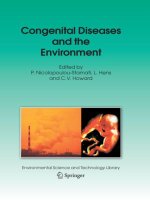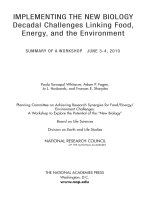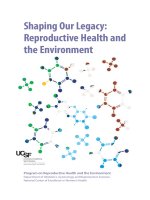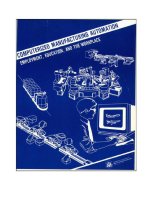Energy and the Environment ppt
Bạn đang xem bản rút gọn của tài liệu. Xem và tải ngay bản đầy đủ của tài liệu tại đây (2.92 MB, 337 trang )
Energy and the Environment
James A. Fay
Dan S. Golomb
OXFORD UNIVERSITY PRESS
ENERGY AND THE ENVIRONMENT
MIT-PAPPALARDO SERIES IN MECHANICAL ENGINEERING
Series Editors: ROHAN C. ABEYARATNE AND NAM P. SUH
ENERGY AND THE ENVIRONMENT
James A. Fay and Dan S. Golomb
A
XIOMATIC DESIGN:ADVANCES AND APPLICATIONS
Nam P. Suh
ENERGY AND THE
ENVIRONMENT
James A. Fay
Department of Mechanical Engineering
Massachusetts Institute of Technology
Dan S. Golomb
Department of Environmental, Earth, and Atmospheric Sciences
University of Massachusetts Lowell
New York ◆ Oxford
OXFORD UNIVERSITY PRESS
2002
Oxford University Press
Oxford New York
Athens Auckland Bangkok Bogot´a Buenos Aires Cape Town
Chennai Dar es Salaam Delhi Florence Hong Kong Istanbul Karachi
Kolkata Kuala Lumpur Madrid Melbourne Mexico City Mumbai Nairobi
Paris S˜ao Paulo Shanghai Singapore Taipei Tokyo Toronto Warsaw
and associated companies in
Berlin Ibadan
Copyright © 2002 MIT
Published by Oxford University Press, Inc.
198 Madison Avenue, New York, New York, 10016
Oxford is a registered trademark of Oxford University Press
All rights reserved. No part of this publication may be reproduced,
stored in a retrieval system, or transmitted, in any form or by any means,
electronic, mechanical, photocopying, recording, or otherwise,
without the prior permission of Oxford University Press.
Library of Congress Cataloging-in-Publication Data
Fay, James A.
Energy and the environment / James A. Fay, Dan S. Golomb.
p. cm.—(The MIT-Pappalardo Series in Mechanical Engineering)
Includes bibliographical references and index.
ISBN 0-19-515092-9
1. Power resources—Environmental aspects. I. Golomb, D. II. Title. III. Series.
TD195.E49 F39 2002
333.79
14–dc21 2001036249
Printing number:987654321
Printed in the United States of America
on acid-free paper
To Gay and Claire
This page intentionally left blank
CONTENTS
List of Tables xv
Foreword xvii
Preface xix
1 Energy and the Environment 1
1.1 Introduction 1
1.1.1 An Overview of This Text 2
1.2 Energy 6
1.2.1 Electric Power 7
1.2.2 Transportation Energy 8
1.2.3 Energy as a Commodity 9
1.3 The Environment 10
1.3.1 Managing Industrial Pollution 11
2 Global Energy Use and Supply 12
2.1 Introduction 12
2.2 Global Energy Consumption 12
2.3 Global Energy Sources 14
2.4 Global Electricity Consumption 16
2.5 Global Carbon Emissions 18
2.6 End-Use Energy Consumption in the
United States 19
2.6.1 Industrial Sector 20
2.6.2 Residential Sector 21
2.6.3 Commercial Sector 21
2.6.4 Transportation Sector 22
2.7 Global Energy Supply 22
2.7.1 Coal Reserves 22
2.7.2 Petroleum Reserves 24
2.7.3 Unconventional Petroleum Resources 25
vii
viii ◆ CONTENTS
2.7.4 Natural Gas Reserves 25
2.7.5 Unconventional Gas Resources 26
2.7.6 Summary of Fossil Reserves 27
2.8 Conclusion 27
Problems 28
Bibliography 29
3 Thermodynamic Principles of Energy Conversion 30
3.1 Introduction 30
3.2 The Forms of Energy 31
3.2.1 The Mechanical Energy of Macroscopic Bodies 31
3.2.2 The Energy of Atoms and Molecules 32
3.2.3 Chemical and Nuclear Energy 32
3.2.4 Electric and Magnetic Energy 33
3.2.5 Total Energy 33
3.3 Work and Heat Interactions 33
3.3.1 Work Interaction 34
3.3.2 Heat Interaction 35
3.4 The First Law of Thermodynamics 35
3.5 The Second Law of Thermodynamics 36
3.6 Thermodynamic Properties 37
3.7 Steady Flow 39
3.8 Heat Transfer and Heat Exchange 39
3.9 Combustion of Fossil Fuel 41
3.9.1 Fuel Heating Value 42
3.10 Ideal Heat Engine Cycles 45
3.10.1 The Carnot Cycle 46
3.10.2 The Rankine Cycle 48
3.10.3 The Otto Cycle 51
3.10.4 The Brayton Cycle 53
3.10.5 Combined Brayton and Rankine Cycles 55
3.11 The Vapor Compression Cycle: Refrigeration and Heat Pumps 56
3.12 Fuel Cells 58
3.13 Fuel (Thermal) Efficiency 62
3.14 Synthetic Fuels 63
3.14.1 The Hydrogen Economy 64
3.15 Conclusion 65
Problems 66
Bibliography 68
Contents ◆ ix
4 Electrical Energy Generation, Transmission, and Storage 69
4.1 Introduction 69
4.2 Electromechanical Power Transformation 72
4.3 Electric Power Transmission 76
4.3.1 AC/DC Conversion 78
4.4 Energy Storage 78
4.4.1 Electrostatic Energy Storage 78
4.4.2 Magnetic Energy Storage 80
4.4.3 Electrochemical Energy Storage 81
4.4.4 Mechanical Energy Storage 83
4.4.5 Properties of Energy Storage Systems 84
4.5 Conclusion 85
Problems 86
Bibliography 87
5 Fossil-Fueled Power Plants 88
5.1 Introduction 88
5.2 Fossil-Fueled Power Plant Components 89
5.2.1 Fuel Storage and Preparation 89
5.2.2 Burner 90
5.2.3 Boiler 91
5.2.4 Steam Turbine 93
5.2.4.1 Impulse Turbine 93
5.2.4.2 Reaction Turbine 94
5.2.5 Gas Turbine 95
5.2.6 Condenser 96
5.2.7 Cooling Tower 97
5.2.7.1 Wet Cooling Tower 97
5.2.7.2 Dry Cooling Tower 98
5.2.8 Generator 98
5.2.9 Emission Control 99
5.2.9.1 Control of Products of Incomplete Combustion and
Carbon Monoxide
99
5.2.9.2 Particle Control 99
5.2.9.3 Sulfur Control 104
5.2.9.4 Nitrogen Oxide Control 109
5.2.9.5 Toxic Emissions 112
5.2.10 Waste Disposal 112
5.3 Advanced Cycles 113
5.3.1 Combined Cycle 113
x ◆ CONTENTS
5.3.2 Coal Gasification Combined Cycle 114
5.3.3 Cogeneration 115
5.3.4 Fuel Cell 116
5.4 Conclusion 116
Problems 117
Bibliography 119
6 Nuclear-Fueled Power Plants 120
6.1 Introduction 120
6.2 Nuclear Energy 121
6.3 Radioactivity 122
6.3.1 Decay Rates and Half-Lives 124
6.3.2 Units and Dosage 124
6.3.2.1 Biological Effects of Radiation 126
6.3.2.2 Radiation Protection Standards 126
6.4 Nuclear Reactors 127
6.4.1 Boiling Water Reactor (BWR) 129
6.4.2 Pressurized Water Reactor (PWR) 130
6.4.3 Gas-Cooled Reactor (GCR) 132
6.4.4 Breeder Reactor (BR) 132
6.5 Nuclear Fuel Cycle 134
6.5.1 Mining and Refining 134
6.5.2 Gasification and Enrichment 135
6.5.3 Spent Fuel Reprocessing and Temporary
Waste Storage 136
6.5.4 Permanent Waste Disposal 137
6.6 Fusion 138
6.6.1 Magnetic Confinement 139
6.6.2 Laser Fusion 139
6.7 Summary 140
Problems 141
Bibliography 142
7 Renewable Energy 143
7.1 Introduction 143
7.2 Hydropower 145
7.2.1 Environmental Effects 148
7.3 Biomass 148
7.3.1 Environmental Effects 151
7.4 Geothermal Energy 152
7.4.1 Environmental Effects 154
Contents ◆ xi
7.5 Solar Energy 155
7.5.1 The Flat Plate Collector 159
7.5.2 Focusing Collectors 161
7.5.3 Photovoltaic Cells 164
7.6 Wind Power 166
7.6.1 Environmental Effects 172
7.7 Tidal Power 172
7.7.1 Environmental Effects 176
7.8 Ocean Wave Power 176
7.9 Ocean Thermal Power 180
7.10 Capital Cost of Renewable Electric Power 181
7.11 Conclusion 183
Problems 183
Bibliography 186
8 Transportation 188
8.1 Introduction 188
8.2 Internal Combustion Engines for Highway Vehicles 191
8.2.1 Combustion in SI and CI Engines 193
8.3 Engine Power and Performance 195
8.3.1 Engine Efficiency 197
8.4 Vehicle Power and Performance 199
8.4.1 Connecting the Engine to the Wheels 201
8.5 Vehicle Fuel Efficiency 203
8.5.1 U.S. Vehicle Fuel Efficiency Regulations and
Test Cycles 203
8.5.2 Improving Vehicle Fuel Economy 205
8.5.2.1 Improving Vehicle Performance 205
8.5.2.2 Improving Engine Performance 207
8.6 Electric Drive Vehicles 208
8.6.1 Vehicles Powered by Storage Batteries 208
8.6.2 Hybrid Vehicles 210
8.6.3 Fuel Cell Vehicles 211
8.7 Vehicle Emissions 214
8.7.1 U.S. Vehicle Emission Standards 214
8.7.2 Reducing Vehicle Emissions 216
8.7.2.1 Reducing Engine-Out Emissions 218
8.7.2.2 Catalytic Converters for Exhaust Gas Treatment 218
8.7.2.3 Evaporative Emissions 220
xii ◆ CONTENTS
8.7.2.4 Reducing CI Engine Emissions 221
8.7.2.5 Fuel Quality and Its Regulation 221
8.8 Conclusion 222
Problems 223
Bibliography 225
9 Environmental Effects of Fossil Fuel Use 226
9.1 Introduction 226
9.2 Air Pollution 227
9.2.1 U.S. Emission Standards 228
9.2.2 U.S. Ambient Standards 231
9.2.3 Health and Environmental Effects of
Fossil-Fuel-Related Air Pollutants 233
9.2.4 Air-Quality Modeling 234
9.2.4.1 Air Pollution Meteorology 235
9.2.4.2 Modeling of Steady-State Point Source 237
9.2.4.3 Plume Rise 239
9.2.4.4 Steady-State Line Source 240
9.2.4.5 Steady-State Area Source 241
9.2.5 Photo-oxidants 242
9.2.5.1 Photo-oxidant Modeling 244
9.2.6 Acid Deposition 247
9.2.6.1 Acid Deposition Modeling 251
9.2.6.2 Transfer Coefficients 253
9.2.6.3 Source Apportionment 255
9.2.7 Regional Haze and Visibility Impairment 256
9.3 Water Pollution 258
9.3.1 Acid Mine Drainage and Coal Washing 258
9.3.2 Solid Waste from Power Plants 259
9.3.3 Water Use and Thermal Pollution
from Power Plants 260
9.3.4 Atmospheric Deposition of Toxic Pollutants
onto Surface Waters 260
9.3.4.1 Toxic Metals 260
9.3.4.2 Polycyclic Aromatic Hydrocarbons 261
9.4 Land Pollution 262
9.5 Conclusion 262
Problems 263
Bibliography 266
Contents ◆ xiii
10 Global Warming 267
10.1 Introduction 267
10.2 What Is the Greenhouse Effect? 269
10.2.1 Solar and Terrestrial Radiation 269
10.2.2 Sun–Earth–Space Radiative Equilibrium 270
10.2.3 Modeling Global Warming 272
10.2.4 Feedback Effects 274
10.2.4.1 Water Vapor Feedback 274
10.2.4.2 Cloud-Radiation Feedback 275
10.2.4.3 Aerosol Feedback 275
10.2.4.4 Ice–Albedo Feedback 275
10.2.4.5 Ocean Circulation Feedback 275
10.2.5 Results of Global Warming Modeling 276
10.2.6 Observed Trend of Global Warming 276
10.2.7 Other Effects of Global Warming 277
10.2.7.1 Sea Level Rise 277
10.2.7.2 Climate Changes 278
10.3 Greenhouse Gas Emissions 279
10.3.1 Carbon Dioxide Emissions and the
Carbon Cycle 279
10.3.2 Methane 281
10.3.3 Nitrous Oxide 281
10.3.4 Chlorofluorocarbons 282
10.3.5 Ozone 282
10.3.6 GHG Control 283
10.4 Controlling CO
2
Emissions 283
10.4.1 End-Use Efficiency Improvements
and Conservation 283
10.4.2 Supply-Side Efficiency Improvements 284
10.4.3 CO
2
Capture 285
10.4.3.1 Air Separation–CO
2
Recycling 285
10.4.3.2 Solvent Absorption 286
10.4.3.3 Membrane Separation 287
10.4.4 CO
2
Sequestration 288
10.4.4.1 Depleted Oil and Gas Reservoirs 288
10.4.4.2 Deep Ocean 289
10.4.4.3 Deep Aquifers 292
10.4.5 CO
2
Utilization 292
10.4.6 Shift to Non-fossil Energy Sources 294
xiv ◆ CONTENTS
10.5 Conclusion 294
Problems 296
Bibliography 297
11 Concluding Remarks 298
11.1 Energy Resources 298
11.2 Regulating the Environmental Effects of Energy Use 299
11.3 Global Warming 300
Appendix A Measuring Energy 302
Index 307
LIST OF TABLES
2.1 Population, Energy Use, GDP, Energy Use per Capita, and Energy Use
per $ GDP in Several Countries, 1996 14
2.2 Carbon Emissions, Carbon Emissions per Capita, and per $ GDP in
Several Countries of the World, 1996 19
2.3 Composition and Characteristics of Coal, Percent by Weight 23
2.4 The World’s Proven Fossil Fuel Reserves, Rates of Consumption, and
Lifetimes 27
3.1 Thermodynamic Properties of Fuel Combustion at 25
◦
C and One
Atmosphere Pressure 44
3.2 Fuel (Thermal) Efficiencies of Current Power Technologies 62
3.3 Thermal Efficiencies of Synthetic Fuel Production 64
4.1 Properties of Battery Systems 83
4.2 Properties of Energy Storage Systems 85
6.1 Some Isotopes in the Nuclear Fuel Cycle, with Half-Lives and Radiation 125
7.1 1997 U.S. Renewable Energy Production 144
7.2 Average Energy Flux in Renewable Energy Systems 145
7.3 Hydropower Development in the United States in 1980 146
7.4 Installed Electrical and Thermal Power of Geothermal Systems in 1993 152
7.5 Clear-Sky Irradiance at 40
◦
N Latitude 158
7.6 Tidal Power Plant Characteristics 175
7.7 Capital Cost of Renewable Electric Power 182
8.1 1995 U.S. Transportation Vehicle Use 190
8.2 2000 Model Year Passenger Vehicle Characteristics (SI Engines) 198
8.3 2000 Model Year Electric Vehicle Characteristics 209
8.4 2000 Model Year Hybrid Electric Vehicle Characteristics 210
8.5 Characteristics of Prototype Fuel Cell Vehicles 213
8.6 U.S. Vehicle Exhaust Emission Standards 216
xv
xvi ◆ LIST OF TABLES
9.1 U.S. NSPS Emission Standards for Fossil Fuel Steam Generators with
Heat Input > 73 MW (250 MBtu/h) 229
9.2 U.S. Federal Vehicle Emission Standards 230
9.3 U.S. 2000 National Ambient Air Quality Standards (NAAQS) 232
9.4 Effects of Criteria Air Pollutants on Human Health, Fauna and Flora,
and Structures and Materials 234
9.5 Pasquill–Gifford Stability Categories 236
9.6 Optimized Sulfate Deposition Model Parameters 253
A.1 SI Units 304
A.2 U.S. Commercial Units 305
A.3 Measured Quantities 306
A.4 SI Unit Prefixes 306
FOREWORD
In 1996, the MIT Department of Mechanical Engineering adopted a new undergraduate curricu-
lum to enhance the learning process of its students. In this new curriculum, key concepts of
engineering are taught in four integrated sequences: the thermodynamics/heat transfer/fluid me-
chanics sequence, the mechanics/materials sequence, the design/manufacturing sequence, and the
systems/dynamics/control sequence. In each one of the four sequences, the basic principles are
presented in the context of real engineering problems that require simultaneous use of all basic
principles to solve engineering tasks ranging from synthesis to analysis. Active learning, including
hands-on experience, is a key element of this new curriculum.
To support new instructional paradigms of the curriculum, the faculty began the development
of teaching materials such as books, software for web-based education, and laboratory experiments.
This effort at MIT is partially funded by the Neil and Jane Pappalardo fund, a generous endowment
created at MIT in support of this project by the Pappalardos. Mr. Neil Pappalardo, an alumnus of
MIT, is the founder and CEO of Medical Technology Information, Inc., and Mrs. Jane Pappalardo
is a graduate of Boston University, active in many civic functions of Massachusetts.
Oxford University Press and MIT have created the MIT-Pappalardo Series in Mechanical
Engineering to publish books authored by its faculty under the sponsorship of the Pappalardo
fund. All the textbooks written for the core sequences, as well as other professional books, will be
published under this series.
This volume, Energy and the Environment by James A. Fay and Dan S. Golomb, differs from
the others in that it is not itself a subject in the core curriculum. Instead, it is an upper-level
subject that draws upon the dynamics, fluid mechanics, thermodynamics, heat transfer, and related
sciences of the core curriculum. While exposing the student to a societal problem of great current
concern—namely, the use of energy and the local, regional, and global environmental effects that
use engenders—it utilizes core curriculum skills in describing and analyzing the modern technology
being used to ameliorate these adverse environmental effects. It enables the student to integrate
this understanding into an appreciation of both the technology and science that must be employed
by nations to maintain a livable environment while providing improved economic circumstances
for their populations.
Energy and the Environment provides many provocative examples of advancing a student’s
skills in engineering fundamentals. Calculating how much power is needed to propel an automobile,
how mechanical power can be extracted from the dynamical motion of the wind or ocean waves and
the pull of gravity on river flows and tidal motions, how fuel cells and batteries generate electric
power from chemical reactions, how power can be generated by the combustion of fossil fuels
in conventional power plants, and how gaseous atmospheric contaminants can change the earth’s
xvii
xviii ◆ FOREWORD
temperature requires integration of the understanding achieved in core studies. Equally important
is the quantitative understanding of the contamination of the atmosphere and surface waters by the
toxic byproducts of energy use, their effects upon human health and natural ecological systems,
and how these effects can be ameliorated by improvements in the technology of energy use.
We expect that the addition of this volume to the others of this series will expand the student’s
understanding of the role of mechanical engineering in modern societies.
Rohan C. Abeyaratne
Nam P. Suh
Editors
MIT-Pappalardo Series
PREFACE
The impetus for creating this book was provoked by one of us (DSG) as a consequence of lecturing on
the subject of energy and the environment for the past 10 years at the University of Massachusetts
Lowell to students in the Colleges of Engineering and Arts and Sciences. In all those years a
diligent search did not unearth a suitable textbook to match the syllabus of that course. To be
sure, numerous texts exist on the subjects of energy, energy systems, energy conversion, energy
resources, and fossil, nuclear, and renewable energy. Also, there are texts on air pollution and its
control, effluents and solid waste from energy mining and usage, the greenhouse effect, and so on.
However, we were unable to find a contemporary text that discusses on a deeper technical level the
relationship between energy usage and environmental degradation or that discusses the means and
ways that efficiency improvements, conservation, and shifts to less polluting energy sources could
lead to a healthier and safer environment.
Our book is intended for upper-level undergraduate and graduate students and for informed
readers who have had a solid dose of science and mathematics. While we do try to refresh the
student’s and reader’s memory on some fundamental aspects of physics, chemistry, engineer-
ing and geophysical sciences, we are not bashful about using some advanced concepts, the ap-
propriate mathematical language, and chemical equations. Each chapter is accompanied by a
set of numerical and conceptual problems designed to stimulate creative thinking and problem
solving.
Chapter 1 is a general introduction to the subject of energy, its use, and its environmental
effects. It is a preview of the subsequent chapters and sets the context of their development.
In Chapter 2 we survey the world’s energy reserves and resources. We review historic trends
of energy usage and estimates of future supply and demand. This is done globally, by continent and
country, by energy use sector, and by proportion to population and gross domestic product. The
inequalities of global energy supply and consumption are discussed.
Chapter 3 is a refresher of thermodynamics. It reviews the laws that govern the conversion of
energy from one form to another—that is, the first and second laws of thermodynamics and the
concepts of work, heat, internal energy, free energy, and entropy. Special attention is given to the
combustion of fossil fuels. Various ideal thermodynamic cycles that involve heat or combustion
engines are discussed—for example, the Carnot, Rankine, Brayton, and Otto cycles. Also, advanced
and combined cycles are described, as well as nonheat engines such as the fuel cell. The principles
of the production of synthetic fuels from fossil fuels are treated.
The generation and transmission of electrical power, as well as the storage of mechanical and
electrical energy, are covered in Chapter 4. Electrostatic, magnetic, and electrochemical storage of
electrical energy is treated, along with various mechanical energy storage systems.
xix
xx ◆ PREFACE
The generation of electricity in fossil-fueled power plants is thoroughly discussed in Chapter
5. The complete workings of a fossil-fueled power plant are described, including fuel storage
and preparation, burners, boilers, turbines, condensers, and generators. Special emphasis is placed
on emission control techniques, such as particulate matter control with electrostatic precipitators,
sulfur oxide control with scrubbers, and nitric oxide control with low-NO
x
burners and flue gas
denitrification. Alternative coal-fired power plants are discussed, such as fluidized bed combustion
and coal gasification combined cycle.
In Chapter 6 we describe electricity generation in nuclear-fueled power plants. Here we re-
view the fundamentals of nuclear energy: atoms, isotopes, the nucleus and electrons, protons and
neutrons, radioactivity, nuclear stability, fission, and fusion. The nuclear fuel cycle is described,
including mining, purification, enrichment, fuel rod preparation, and spent fuel (radioactive waste)
disposal. The workings of nuclear reactors are discussed, including control rods, moderators, and
neutron economy, as well as the different reactor types: boiling water, pressurized water, and breeder
reactors.
The principles of renewable energy utilization are explained in Chapter 7. This includes hy-
dropower, biomass, geothermal, solar thermal and photovoltaic, wind, tidal, ocean wave, and
ocean thermal power production. Attention is given to the capacity factor and capital cost of these
systems.
Chapter 8 is devoted principally to the automobile, because road vehicles consume roughly
one-third of all primary energy and also because the transportation of people and goods is so
dependent upon them. The characteristics of the internal combustion engine are described, for both
gasoline and diesel engines. The importance of vehicle characteristics for vehicle fuel efficiency
is stressed. Electric drive vehicles are described, including battery-powered and hybrid vehicles.
Vehicle emissions are explained, and the technology for reducing them is described.
A survey of the environmental effects of fossil fuel usage begins in Chapter 9. In this chapter
we discuss urban and regional air pollution, the transport and dispersion of particulate matter, sulfur
oxides, nitrogen oxides, carbon monoxide, and other toxic pollutants from fossil fuel combustion,
and the effects of these pollutants on human health, biota, materials, and aesthetics. The phenomena
of photochemical smog, acid deposition and regional haze are also described. Also treated are the
impacts of energy usage on water and land.
Chapter 10 continues the survey of environmental effects of fossil fuel combustion with particu-
lar reference to global climate change resulting from anthropogenic enhancement of the greenhouse
effect. Here we discuss the carbon dioxide emission trends and forecast, the global carbon cycle,
and the uptake of CO
2
by the oceans and biota. The physics of the greenhouse effect is described in
some detail, as well as the predicted consequences to the planet and its inhabitants if CO
2
emissions
continue unabated.
We conclude with Chapter 11, a reemphasis of the important relationships among the science,
technology, and economics of energy usage and its environmental effects. We note the limited
success of regulation of urban and regional air pollution in industrialized nations, and we also note
the great challenge that lies ahead in dealing with global climate change.
Finally, we include Appendix A, an explanation of the scientific and engineering units that are
commonly used in energy studies, easing the translation from one set to another.
Preface ◆ xxi
The authors wish to express their appreciation to colleagues who aided in the review of the
manuscript: John Heywood, Wai K. Cheng, and Jason Mark. Of course, the authors bear complete
responsibility for the accuracy of this text. We also thank George Fisher for preparing many of the
tables and figures.
James A. Fay
Massachusetts Institute of Technology
Dan S. Golomb
University of Massachusetts Lowell
This page intentionally left blank
CHAPTER
1Energy and the Environment
1.1 INTRODUCTION
Modern societies are characterized by a substantial consumption of fossil and nuclear fuels needed
to provide for the operation of the physical infrastructure upon which these societies depend: the
production of food and water, clothing, shelter, transportation, communication, and other essen-
tial human services. The amount of this energy use and its concentration in the urban areas of
industrialized nations has caused the environmental degradation of air-, water- and land-dependent
ecosystems on a local and regional scale, as well as adverse health effects in human populations.
Recent scientific studies have forecast potentially adverse global climate changes that would result
from the accumulation of gaseous emissions to the atmosphere, principally carbon dioxide from
energy related sources. This accumulation is aggravated by an expected expanding consumption
of energy both by industrialized nations and by developing nations seeking to improve the living
standards of their growing populations. The nations of the world, individually and collectively, are
undertaking to limit the damage to human health and natural ecosystems that attend these current
problems and to forestall the development of even more severe ones in the future. But because
the source of the problem, energy usage, is so intimately involved in nations’ and the world’s
economies, it will be difficult to ameliorate this environmental degradation without some adverse
effects on the social and economic circumstances of national populations.
To comprehend the magnitude of intensity of human use of energy in current nations, we might
compare it with the minimum energy needed to sustain an individual human life, that of the caloric
value of food needed for a healthy diet. In the United States, which is among the most intensive
users of energy, the average daily fossil fuel use per capita amounts to 56 times the necessary daily
food energy intake. On the other hand, in India, a developing nation, the energy used is only 3 times
the daily food calorie intake. U.S. nationals expend 20 times the energy used by Indian nationals,
and their per capita share of the national gross domestic product is 50 times greater. Evidently, the
economic well-being of populations is closely tied to their energy consumption.
When agricultural technology began to displace that of the hunter–gatherer societies about
10,000 years ago, activities other than acquiring food became possible. Eventually other sources
of mechanical energy—that of animals, wind, and water streams—were developed, augmenting
human labor and further enhancing both agricultural and nonagricultural pursuits. As world popula-
tion increased, the amount of crop and pasture land increased in proportion, permanently replacing
natural forest and grassland ecosystems by less diverse ones. Until the beginning of the industrial
revolution several centuries ago, this was the major environmental impact of human activities.
Today, we are approaching the limit of available land for agricultural purposes, and only more
intensive use of it can provide food for future increases of world population.
1
2 ◆ ENERGY AND THE ENVIRONMENT
The industrial revolution drastically changed the conditions of human societies by making
available large amounts of energy from coal (and later oil, gas, and nuclear fuel) far exceeding that
available from the biofuel, wood. Some of this energy was directed to increasing the productivity
of agriculture, freeing up a large segment of the population for other beneficial activities. Urban
populations grew rapidly as energy-using activities, such as manufacturing and commerce, concen-
trated themselves in urban areas. Urban population and population density increased, while those
of rural areas decreased.
By the middle of the twentieth century, nearly all major cities of the industrialized world
experienced health-threatening episodes of air pollution, and today this type of degradation has
spread to the urban areas of developing countries as a consequence of the growing industrialization
of their economies. Predominantly, urban air pollution is a consequence of the burning of fossil fuels
within and beyond the urban region itself. This pollution can extend in significant concentrations
to rural areas at some distance from the pollutant sources so that polluted regions of continental
dimensions even include locations where there is an absence of local energy use.
Despite the severity of urban pollution, it is technically possible to reduce it to harmless levels
by limiting the emission of those chemical species that cause the atmospheric degradation. The
principal pollutants comprise only a very small fraction of the materials processed and can be made
even smaller, albeit at some economic cost. In industrialized countries, the cost of abating urban
air pollution is but a minor slice of a nation’s economic pie.
While the industrialized nations grapple with urban and regional air pollution, with some
success, and developing nations lose ground to the intensifying levels of harmful urban air con-
tamination, the global atmosphere experiences an untempered increase in greenhouse gases, those
pollutants that are thought to cause the average surface air temperature to rise and climate to be
modified. Unlike the urban pollutants, most of which are precipitated from the atmosphere within
a few days of their emission, greenhouse gases accumulate in the atmosphere for years, even cen-
turies. The most common greenhouse gas is carbon dioxide, which is released when fossil fuels
are burned. As it is not possible to utilize the full energy of fossil fuels without forming carbon
dioxide, it will be very difficult to reduce the global emissions of carbon dioxide while still provid-
ing enough energy to the world’s nations for the improvement of their economies. While there is
technology available or being developed that would make possible substantial reductions in global
carbon dioxide emissions, the cost of implementation of such control programs will be much larger
than that for curbing urban air pollution.
1.1.1 An Overview of This Text
This book describes the technology and scientific understanding by which the world’s nations could
ameliorate the growing urban, regional, and global environmental problems associated with energy
use while still providing sufficient energy to meet the needs of populations for a humane existence.
It focuses on the technology and science, the base on which any effective environmental control
program must be built. It does not prescribe control programs, because they must include social,
economic, and political factors that lie outside the scope of this book. We do not delve deeply into
the science and technology, but do provide an adequate description of the fundamental principles
and their consequences to the topic at hand. We present a bibliography in each chapter for the use
of the reader who wants to pursue some aspects at greater depth.
The major sources of energy for modern nations are fossil fuels, nuclear fuels, and hydropower.
Non-hydro renewable energy sources, such as biomass, wind, geothermal, solar thermal, and

